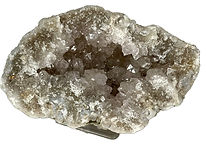
Lida Asteria
Next-Level Geode Collecting…
-What should I be looking for when I crack open a geode?
-Are there rare minerals, mineral combinations, inclusions, formations?
After collecting for awhile you may find yourself asking these questions. For the collector, and enthusiast, this opens all new doors of exploration. Take a closer look at your geode and be amazed by the creation that the earth has left for us to enjoy.
Without question, the rarest geodes we have found in Kentucky thus far are our millerite geodes form Halls Gap, and Kings Mountain and our prized dewdrop diamond geodes from Lincoln county. Quite a few millerite geodes have been found in Kentucky at the famous Halls Gap location, but as far as we know, we are the only collectors to ever find dewdrop diamond geodes in Kentucky…and if we hadn’t done our research, we would have never known what they were. The dewdrop diamond geode consists of both, a rare mineral combination (white chalcedony and clear/smoky quartz) and rare crystal formation (bipyramidal quartz).
Here are pictures of a couple of our millerite and dewdrop finds:
The first thing you need when you begin to investigate a geode is a quality loop. You’ll want one with built-in lighting (LED is best). You can purchase one through our website or ebay store..
Rare minerals:
The list of minerals found in KY geodes is likely not complete, there’s always a chance a new one will be discovered. The list (and pictures) of minerals already found in Kentucky geodes is a long one, and can be researched on www.mindat.org
The rarest mineral is probably millerite, found from Halls Gap…but who knows, you might discover a new one!
Rare mineral combinations:
Any time you find a “well mineralized” geode, consider yourself lucky. Usually the more minerals that are present, the better. Geodes with quartz (large and/or micro), dolomite, calcite, sphalerite, pyrite, etc can get very interesting when there’s combinations. Keep your eye out for smaller minerals, like pyrite “dusting” on quartz or dogtooth calcite crystals. Also for micro-sized crystals of chalcopyrite, galena, sphalerite, marcasite, etc hidden inside the geode.
Below are some pictures of nice mineral combinations: (most pictures will enlarge when clicked)
Inclusions:
Another thing to keep an eye out for are inclusions…A mineral inside of another mineral. You might see millerite hidden inside a calcite crystal…or galena inside a quartz crystal…pyrite inside calcite…or even oil inside of crystals or for bubbles of water inside crystals, those are very rare!
Rare crystal formations:
Rare crystal formations are always fun to look for…here’s a list to get you started (make sure you research the internet for others, and don’t be afraid to email mineral dealers and other collectors to find out what to look for).
Scepters…
Quartz can form into a scepter, keep an eye out for these cool formations (even micro-sized ones).
Split growth, and “artichoke” quartz…
Keep an eye out for these formations, we find them often in KY geodes
Cathedral quartz…
Keep an eye out for these formations as well, we see these often…
Perimorphs and pseudomorphs…
When a mineral overgrows another mineral which is later dissolved, the older mineral’s shape is preserved as a “cast” for the newer mineral, this is a "perimorph"....Keep an eye out for this in KY geodes.
When one mineral replaces another mineral (as opposed to the older mineral dissolving), this is a "pseudomorph"…We see this a lot in KY geodes…Keep an eye out!
Phantoms…
If you’ve watched any episodes of the TV series, Prospectors, you’ve probably heard the term “phantom”. This is a crystal that has another crystal inside it. We see these in KY geodes, so be on the look out…
Rainbow and Iris Quartz...
Cracks inside of quartz crystals, and odd crystal structures can cause irridescent light to form...we see this a lot in KY geodes.
Other cool minerals to keep an eye out for are smoky and amethyst quartz…We find these from time to time in KY geodes. Amethyst quartz was thought to only come from the Kings Mountain locality, but we have found it elsewhere as well. Whether or not the “smoky” quartz from KY is true smoky quartz is up for debate (and testing). True smoky quartz is formed from radiation exposure, and although possible, the smoky quartz found here in our sedimentary rock might get its coloration from inclusions of other dark minerals. One test, which we have not performed (because we don’t want to harm our specimens) is the heat test. If you heat true smoky quartz, it fades. Quartz with inclusions won’t.
For a list of other cool things to look for in your geodes, check this link


Click to enlarge


Chalcedony and pyrite dusted dogtooth calcite

Quartz and stairdtep calcite

Botryoidal chalcedony and pyrite

Quartz and pyrite dusted dolomite

Druzy quartz, pyrite dusted dolomite, and we believe chalcopyrite

Chalcedony and super-rare sulphur crystals

Inclusions of pyrite in chalcedony

Inclusions can explode with color under shortwave UV light

Scepter

Artichoke

Cathedral

Phantom

Rainbow


Kentucky amethyst and smoky quartz






_edited.jpg)